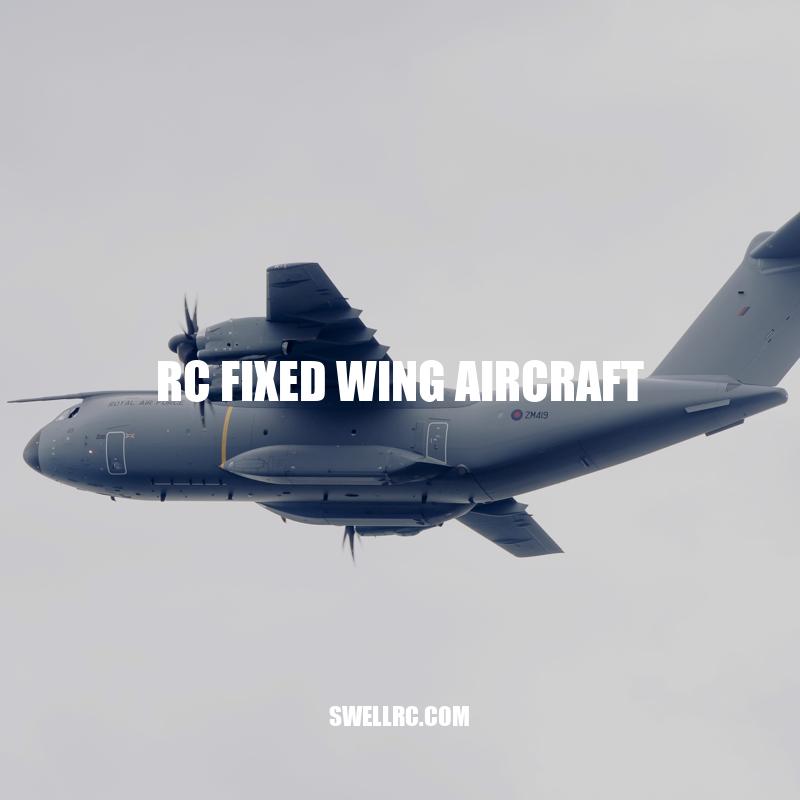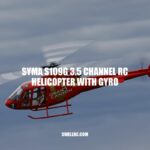RC Fixed-Wing Aircraft: Types, Materials, Flying Tips, and Maintenance
RC fixed-wing aircraft, also known as radio-controlled fixed-wing aircraft or model planes, are miniature aircraft models built to mimic the functionality and performance of full-size aircraft. These planes have become increasingly popular among aviation enthusiasts, modelers, and pilots due to the advancements in technology and affordability of the overhead technology. They are powered by batteries or gasoline engines that work in tandem with the remote control system to allow pilots to operate the plane from a distance. The control system typically consists of a transmitter, receiver, and servos that allow pilots to manipulate the plane’s various functions, including the throttle, rudder, and elevator. RC fixed-wing aircraft come in different types and designs, each suited for pilots’ individual needs and preferences, ranging from beginner models that are easy to operate and maneuver to advanced models that are designed to perform aerobatic maneuvers. RC fixed-wing aircraft, although popular with hobbyists, have also found applications in various industries such as photography, surveying, and agriculture, providing a cost-effective and efficient solution for various aviation needs.
Types of RC Fixed-Wing Aircraft
RC fixed-wing aircraft are available in different sizes, designs, and types that suit varying flying needs and levels of experience. Here are some common types of RC fixed-wing aircraft:
- Trainer planes: These are perfect for beginners looking to learn the basics of flying RC planes. Trainer planes are easy to control, relatively inexpensive, and can tolerate minor crashes.
- Glider planes: These planes are designed to fly without motorized power and rely on lift from the atmosphere to stay in flight. Glider planes can fly for long periods, making them perfect for long-range flights or soaring over landscapes.
- Warbirds: These models are designed to resemble vintage military aircraft and can perform aerobatic maneuvers that simulate combat flights.
- Jets: Jet models are designed to mimic the performance of actual fighter jets, with high speed and maneuverability. These models require advanced skills to operate and are not recommended for beginners.
Another important aspect to consider when purchasing RC fixed-wing aircraft is the materials used to build them. Different materials affect the plane’s weight, durability, and cost. Balsa wood planes, for instance, are more durable than foam planes but require more experience and skill to operate. Carbon fiber models are the most robust and resilient but come at a higher cost. Beginner pilots are advised to start with less expensive electric trainer planes and progress to more advanced models as they gain more experience and expertise. Several online retailers offer a vast selection of RC fixed-wing aircraft, including Amazon, Horizon Hobby, and HobbyKing. Additionally, informational resources such as RCGroups.com and Reddit’s RCPlane community offer helpful discussions and advice for enthusiasts looking to learn more about this entertaining pastime.
What are the types of fixed-wing aircraft?
There are several types of fixed-wing aircraft that serve different purposes. Some of them are:
- Single-engine piston aircraft: Small airplanes that are commonly used for personal transportation or flight training.
- Turboprop aircraft: These have a gas turbine engine combined with a propeller to provide power. They are typically used for regional transportation, freight or military transportation.
- Jet aircraft: Powered by one or more jet engines, these aircraft can operate at high speeds and altitude. They are widely used in commercial aviation, military, and business transportation.
- Glider aircraft: These do not have a propulsion system and rely on wind currents to stay aloft. They are popular for recreational purposes and for training pilots to fly without engine power.
- Amphibian aircraft: Designed to take off and land on both land and water, these planes are useful for rescue and firefighting missions.
For more information on aviation and aircrafts, you can refer to the Federal Aviation Administration (FAA) website or browse through aviation-related products on Amazon.
Materials Used to Build RC Fixed-Wing Aircraft
RC fixed-wing aircraft can be built using different materials, each with its unique features and suitability for specific models. Some common materials include:
- Foam: Foam planes are popular among beginners. They are lightweight, inexpensive, and easy to control compared to other models. Although foam planes are less durable than other materials, they are ideal for indoor flying, and crashes cause minor to no damage.
- Balsa wood: Balsa wood planes are lightweight, durable, and have better aerodynamic features than foam planes. However, they require more experience and skill to operate, and crashes could lead to more significant damage.
- Carbon fiber: Carbon fiber planes are the most robust and resilient and can withstand crashes better than foam or balsa wood models. They also have better aerodynamic features, allowing them to fly faster and further. However, they come at a higher cost than other materials, making them less accessible to beginner pilots.
The table below highlights the pros and cons of each material.
| Material | Pros | Cons |
|---|---|---|
| Foam | Lightweight, easy to control, inexpensive | Less durable, not suitable for outdoor flying in adverse weather conditions |
| Balsa Wood | Lightweight, durable, better aerodynamic features | Requires more experience and skill to operate, crashes can cause significant damage |
| Carbon Fiber | Most robust and resilient, better aerodynamic features | Expensive, less accessible to beginner pilots |
Knowing the differences in materials used to build RC fixed-wing aircraft helps pilots choose the right plane for their needs and experience levels. Moreover, it is essential to note that different materials have varying weights that affect performance. Lighter models tend to fly faster and are susceptible to wind and turbulence, while heavier models fly more steadily and can carry larger payloads.
What materials are used to build an RC plane?
RC planes can be made of various materials, including foam, balsa wood, carbon fiber, and plastic. Each material has its own advantages and disadvantages, affecting the weight, durability, and cost of the plane.
Foam is a popular material due to its affordability and lightweight. It is easy to work with and forgiving for beginners but not as durable as other materials.
Balsa wood is also a popular and traditional material. It is stronger and more durable than foam but requires more skill and time to work with.
Carbon fiber is a strong and lightweight material used for high-performance RC planes. Its strength comes at a higher cost than other materials.
Plastic is used in some RC planes, especially toy models, due to its affordability and durability. However, it may not provide the same level of performance as other materials.
Ultimately, the choice of materials depends on the desired performance, budget, and skill level of the builder. Websites like RC Groups and HobbyKing offer a wide variety of RC plane kits and materials for builders of all skill levels.
Flying an RC Fixed-Wing Aircraft
Flying an RC fixed-wing aircraft requires proper training and experience. Here are some critical things to consider when flying these planes:
- Choose an appropriate location: Look for a location with enough space to fly the plane. Avoid areas with power lines, trees, buildings, or people as these may cause damage to the plane.
- Check the weather: Check the weather conditions before flying. Avoid flying in rainy, windy, or stormy weather as this may cause damage to the plane and affect its performance.
- Pre-flight check: Before taking off, inspect the plane. Ensure that the motor, control surfaces, and transmitter are all working correctly. Test the plane’s controls to ensure they are functioning correctly.
- Takeoff and Landing: To takeoff, apply full throttle, and then gently pull back on the elevator controls. Raise the plane to a comfortable altitude and then level it out. During landing, gently reduce the throttle and slowly pull back on the elevator to bring the plane down gently.
- Control the plane: Use the transmitter to control the plane’s movement. Use the directional stick to maneuver it in the air and the throttle to adjust its altitude.
It is crucial to note that flying RC fixed-wing aircraft requires proper training and experience. Beginners are advised to seek help from experienced pilots as they learn how to operate the remote controller while controlling the plane.
There are several websites and resources available to help people interested in flying RC fixed-wing aircraft. For example, www.rcgroups.com is a community of RC enthusiasts who offer support and advice to new members. Additionally, there are several products available that assist pilots with flying their RC planes, such as flight simulators that help pilots practice their skills and controllers that offer a more comfortable and intuitive flying experience.
What is a fixed-wing RC plane?
A fixed-wing RC plane is a type of radio-controlled aircraft that has a fixed wing structure for lift and stability during flight. Unlike helicopters or drones, fixed-wing planes are propelled forward by a motor and require a certain level of skill to operate. They come in different sizes, shapes, and levels of complexity to fit the needs of various enthusiasts.
Some popular fixed-wing RC planes include the Blizzard SR, E-flite Apprentice STS, and the Flite Test Explorer. Interested buyers can find a variety of planes and related accessories on websites such as Horizon Hobby, Flite Test, and HobbyKing.
| Website | Description |
|---|---|
| Horizon Hobby | A well-known website that offers a wide range of fixed-wing planes, parts, and accessories. They also have a community forum for enthusiasts to share tips and tricks. |
| Flite Test | A website that provides building plans and kits for DIY fixed-wing planes. They also offer a selection of ready-to-fly planes. |
| HobbyKing | An online store that sells a variety of fixed-wing planes and accessories at competitive prices. |
Some key characteristics of fixed-wing RC planes include:
- Require a certain level of skill and hand-eye coordination to operate
- Are propelled forward by a motor and depend on the shape and size of fixed wings for lift and stability during flight
- Come in different sizes, shapes, and levels of complexity to fit the needs of various enthusiasts
- May be used for various activities such as hobby flying, aerial photography, or even scientific research
Maintenance and Repair
Like any other machine, RC fixed-wing aircraft require proper maintenance and repair to ensure they function optimally. Here are some critical things to consider when maintaining and repairing RC fixed-wing aircraft:
- Clean the plane after use: After every flight, wipe down the plane and remove any dirt or debris. This will keep the plane in good condition and prevent dirt from interfering with the plane’s electronics.
- Inspect the motor: Check the motor after use to ensure it is working correctly. Look for any signs of damage such as overheating or abnormal sounds. Replace worn-out parts as needed to maintain optimal performance.
- Inspect the control surfaces: Check the control surfaces after every flight and ensure they are working correctly. Look out for any signs of damage such as cracks or bents that may affect the plane’s performance.
- Replace worn-out parts: Over time, parts such as batteries, propellers, and landing gear may wear out and require replacement. Replace these parts to maintain optimal performance.
- Repair damages: If the plane is damaged in a crash or mishap, it is crucial to repair the damages immediately to avoid further damage that may affect the plane’s performance. Seek help from experienced pilots or repair services if needed.
Regular maintenance and repair of RC fixed-wing aircraft are critical to ensure long-term use and optimal performance. Several websites offer information about maintaining and repairing RC planes, such as flitetest.com. There are also several products available that assist pilots with maintaining and repairing their RC planes, such as canopies, motor mounts, and landing gear.
Why is it necessary to perform aircraft maintenance and repair?
Performing regular maintenance and repair on aircraft is critical for ensuring safety and optimal performance. Here are some reasons why:
- Prevention of mechanical failures and malfunctions during flights.
- Compliance with aviation regulations and guidelines.
- Extension of aircraft lifespan and reduction of operating costs.
- Minimizing potential risks and liability in case of accidents.
It is crucial for airlines and aircraft operators to prioritize maintenance and repair procedures to guarantee passenger and crew safety. To learn more about aircraft maintenance and repair, you can visit the Federal Aviation Administration website or check out companies that specialize in aviation maintenance, such as Lufthansa Technik or AAR CORP.
Conclusion
In conclusion, RC fixed-wing aircraft is an exciting hobby that offers a unique flying experience. Suitable for beginners and professionals alike, these planes come in various types and designs to meet different flying needs. However, it is essential to understand the basics of operating, maintaining and repairing these machines to ensure optimal performance and longevity.
Proper maintenance and repair of RC fixed-wing aircraft can ensure their optimal performance, and detecting problems early can prevent further damage. Regular inspection during cleaning can help identify and correct minor glitches before they become major issues. If a significant problem crops up, experienced pilots can provide helpful insights to help maintain and repair the planes. Numerous websites provide helpful tips and tricks for RC fixed-wing aircraft enthusiasts.
As with any hobby, practicing and honing skills is crucial to succeed in the area. However, anyone willing to invest effort and commitment can master the art of operating and maintaining these aircraft. It can be a rewarding and fun experience that creates fantasies of flight and engages the imagination. Get started, and let your flight story take off!



